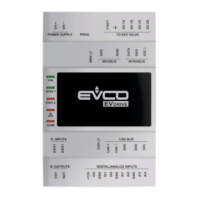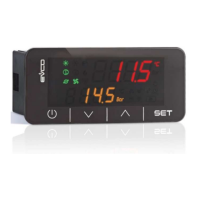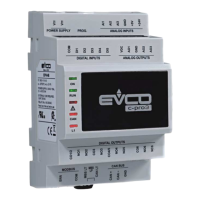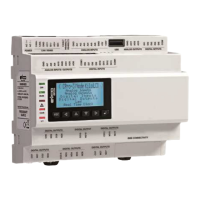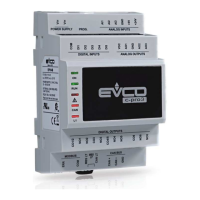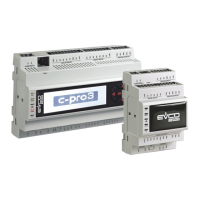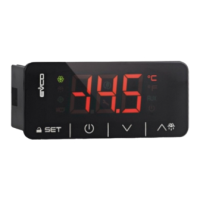EVCO S.p.A.
c-pro 3 nano CHIL | Application manual ver. 1.0 | Code 144CP3NCHE104
page 66 of 90
8.16 Temperature Alarm Check
8.16.1 High and Low Temperature Alarm Management
Based on the operating mode, a check is performed on the input temperature to the exchanger, activating an alarm when necessary.
• In winter operation (heat pump), if the temperature falls below the threshold for a settable timeframe, a “low-temperature”
alarm is generated: AL01.
• In summer operation (chiller), if the input temperature exceeds a certain threshold for a settable timeframe, a “high-
temperature” alarm is generated: AL02
With a configuration parameter you can set the alarms in a way that they are only shown, or stop the machine.
You can also set a delay to inhibit the temperature alarm upon system start-up, in order to give the machine a chance to reach full
power.
• PA05 = High temperature alarm set point
• PA06 = Low temperature alarm set point
• PA07 = Temperature alarm enablement delay
• PA08 = Temperature alarm management means (only shown / machine arrest)
• PA09 = Temperature alarm differential
• PA10 = System start-up alarm inhibition period.
These alarms are detected only when the machine is on.
8.16.2 Management of the primary exchanger efficiency alarm
If this alarm AL03 (and AL13 for Circuit # 2) is enabled (PA25 = 1), a check is performed to verify whether the difference between the
input and output temperatures of the cold water on the primary exchanger are below the Primary exchanger minimum difference
threshold PA26 for a Primary exchanger efficiency alarm bypass period PA27.
This alarm is not managed during defrost if the probes are in alarm mode and this alarm is the manual reset type.
This alarm is detected only when the machine is on.
8.17 Pressure Alarm Control
8.17.1 High pressure switch alarm management
Using the digital input connected to an external pressure switch, you can monitor whether the maximum condensation pressure value is
exceeded. The high-pressure alarm AL11 (and AL12 for Circuit # 2) causes the immediate arrest of the coolant circuit, also switching
off any compressor that might be on and keeping the others from starting up.
This alarm is detected only when the machine is on.
This is a manual reset alarm.
8.17.2 High-pressure transducer management
If the condensation pressure exceeds a certain threshold, a high-pressure alarm AL31 (and AL32 for Circuit # 2) is generated. The
alarm causes the immediate arrest of the coolant circuit, also switching off any compressor that might be on and keeping the others
from starting up.
This alarm is detected only when the machine is on.
This is a manual reset alarm and can be reset if in the meantime the pressure has dropped below the maximum threshold of a certain
differential value.
• PA21 = High pressure alarm set point
• PA22 = High pressure alarm differential
8.17.3 Low pressure switch alarm management (chiller mode)
With a digital input connected to an external pressure switch, you can monitor whether there is minimum supply of pressure in the
coolant circuit. The low-pressure alarm AL41 (and AL42 for Circuit # 2) causes the immediate arrest of the coolant circuit, also
switching off any compressor that might be on and keeping the others from starting up.
Upon start-up of the first compressor, the alarm is delayed for a certain interval to allow the compressors to take the coolant circuit to
maximum pressure.
At first the alarm is the autoresetting type, unless it exceeds a certain number of events in an hour (PA14), circumstance in which it
switches to manual reset.
• PA13 = Low-pressure alarm bypass period
• PA14 = Maximum number of autoresetting low-pressure alarms
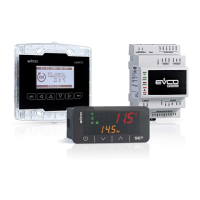
